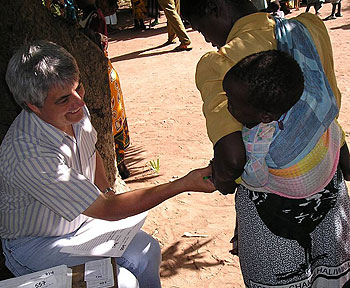An enriched peanut-butter mixture given at home is successfully promoting recovery in large numbers of starving children in Malawi, according to a group of School of Medicine researchers.
Malnutrition affects 70 percent of all Malawian children with an estimated 13 percent of children dying from it before the age of five.

Mark J. Manary, M.D., professor of pediatrics and an emergency pediatrician at St. Louis Children’s Hospital, has spent several years researching the use of the enriched peanut-butter mixture, called Ready-to-Use Therapeutic Food (RUTF) with small groups of severely and moderately malnourished young children in the sub-Saharan African country. The nutrient-rich mixture contains peanuts, powdered milk, oil, sugar and added vitamins and minerals. Produced in a Malawian factory, the mixture is given to the mothers of the children to feed at home.
While Manary’s team had promising results in using the RUTF in a small setting, it hadn’t used the treatment in large-scale operations because of limited human and material resources. The team embarked on a study to implement the peanut-butter feeding program using the existing health-care system in Malawi. Results appeared in the July issue of Maternal and Child Nutrition.
The research team, including Manary, students from WUSTL and Baylor College of Medicine and researchers from Malawi, rolled out the treatment at 12 rural health centers in southern Malawi. There, non-medically trained village health aides, who are often the only medical presence in the communities, identified severely or moderately malnourished children based on World Health Organization guidelines. The aides then followed up with the children for up to eight weeks. Of the 2,131 severely malnourished children treated with the RUTF at home, 89 percent recovered. Of the 806 moderately malnourished children treated with the RUTF, 85 percent recovered.
“The peanut-butter feeding has been a quantum leap in feeding malnourished children in Africa,” Manary said. “The recovery rates are a remarkable improvement from standard therapy.”
Traditional treatment of moderate malnutrition in Malawi involves feeding children a corn-based porridge at home, or for severe malnutrition, children are fed a milk-based porridge in hospitals. However, a severely malnourished child would have to eat about 25 spoonfuls of porridge to equal the calorie density in one spoonful of the concentrated RUTF, Manary said. The recovery rate for children given the standard therapy is less than 50 percent.
As a result of the study, Manary and the researchers found that village health aides can reliably identify which children need treatment, manage the program and follow up with children after the program, which eliminates the need for on-site medically trained professionals to supervise it.
“What’s really exciting to me is that we’ve demonstrated that we can put this research into practice on a large scale, it can benefit tens of thousands of kids, and there are not going to be operational barriers in some very remote settings like sub-Saharan Africa,” Manary said.
First author Zachary Linneman, a WUSTL freshman majoring in biology and Chinese in Arts & Sciences, has traveled to Malawi twice to work with Manary.
“In addition to the success the project brings to each malnourished child in terms of nutritional rehabilitation, I think it demonstrates to the larger community the ability to effectively address major health issues with straightforward solutions and hard work,” Linneman said.
Once the children are renourished, they usually stay healthy, Manary said.
“Mothers in Malawi know that malnutrition is the single biggest threat to their children’s existence,” Manary said. “They want nothing more in this life than to have their children survive and grow up. When their child comes through treatment successfully, they will pay extra attention to make sure it doesn’t happen again.”